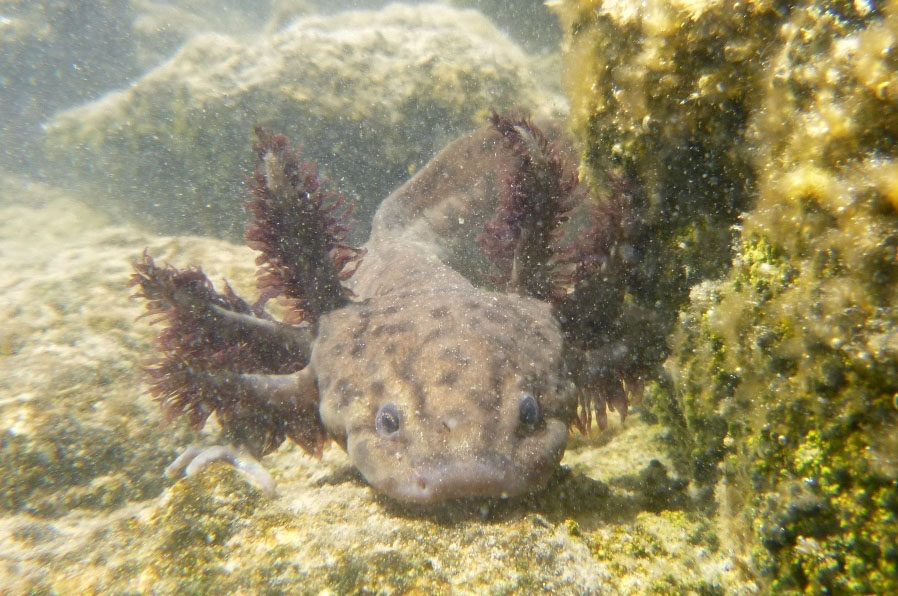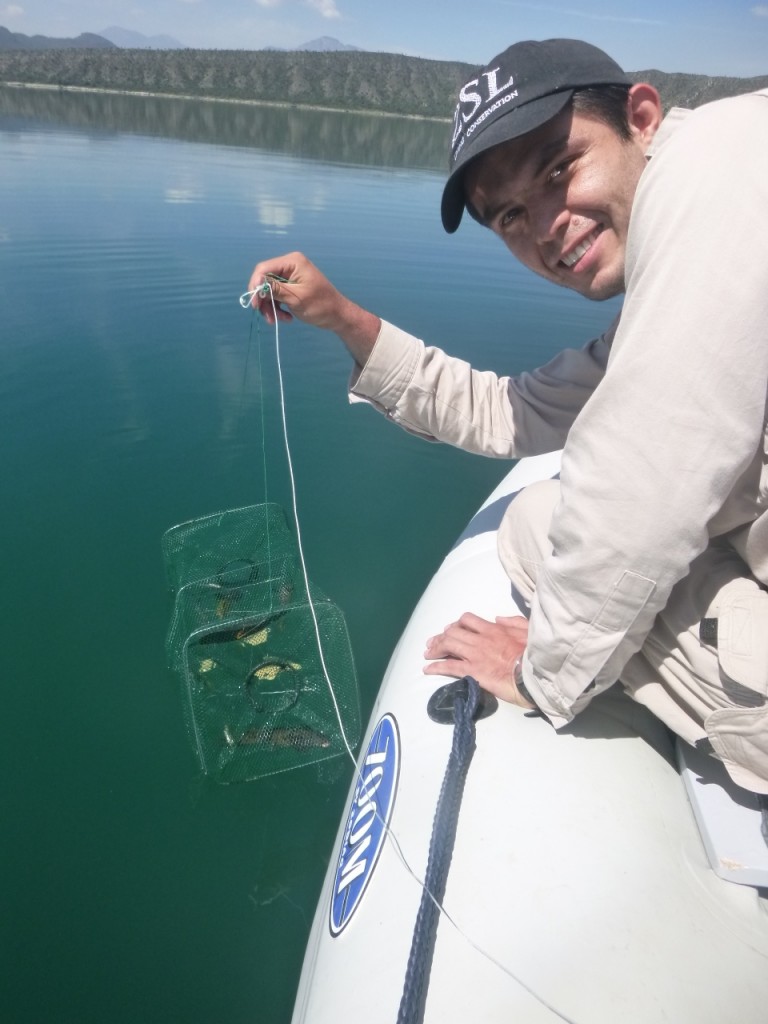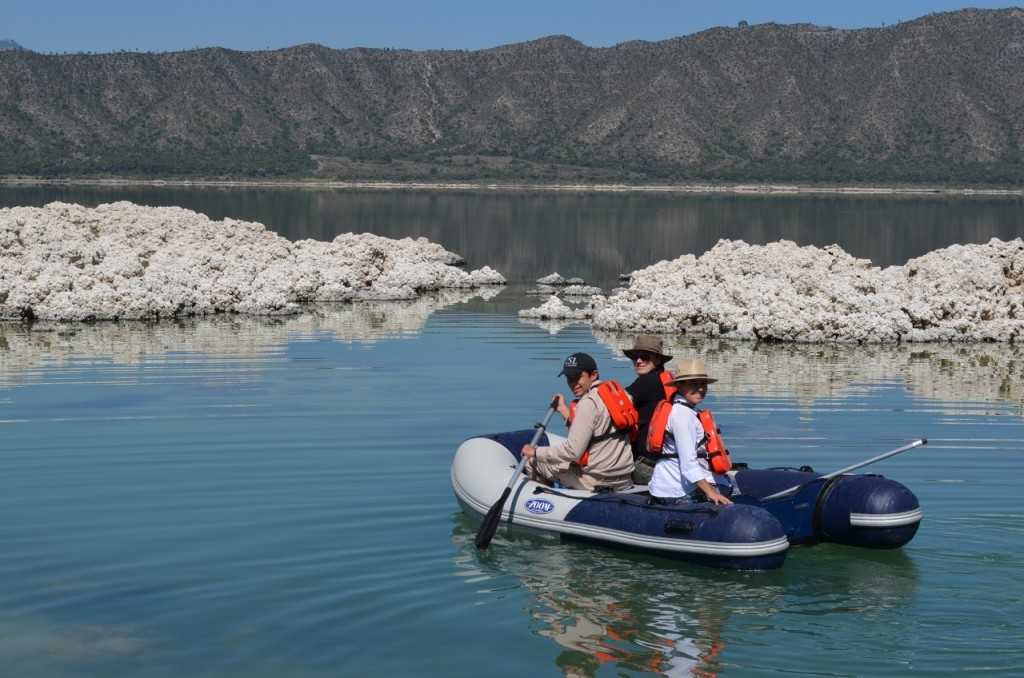
A few weeks ago we started the field work for the Taylor’s Salamander Project in Alchichica. Chris Michaels from ZSL visited the project and came with us to the field to supervise the project and help with all the work. We were four people for this trip: Chris from ZSL, Laura who works in environmental education, my wife María who is the pathologist from Africam Safari, and me. We spent five days in this first trip to Alchichica and the results from the trip were very promising.
On the first day, I organized a rubbish collection with the community. I ask local authorities to help me announce this activity within the community and we started very early in the morning. About 50 people helped us removing rubbish from the edge of the lake and from shallow areas. Men, women and children participated enthusiastically in this activity, some of them swimming with us to remove litter from the water. One of the most exciting moments of the day was when we decided to remove to big tires that were buried in the mud. With a long rope tied to a big truck the tires were taken out of the water, but that was not all, someone found three salamanders inside one of the tires! In that moment, all the people came together to see the salamanders. They were very surprised because most of them had not seen them in the past and had just heard about their existence. People were also very interested in the salamanders and they wanted to know everything about them. At the end, after they took pictures of the salamanders and we answered their questions, we released them back in the lake. Then, people invited us to have breakfast with them.

On the afternoon of the same day, we started setting the traps for the first time. We prepared traps for different depths up to 30 meters, with a string attached to a colorful plastic ball as a “floating device”. The panorama that afternoon was not very positive because it started raining just before we arrived to the lake. Fortunately the rain didn’t last long. About 6 in the afternoon, we started setting the traps. The most difficult part was rowing against the wind. We learnt that the weather is very predictable in the lake. Everyday a strong wind starts blowing after 2PM, so no matter what we did, every afternoon we had to row against the wind. We spent four night surveying the lake with a total of 25 traps set in a different side of the lake each night. Every night, after setting the traps, we spent about an hour looking for salamanders in the edge of the lake with a couple powerful lamps. We found many salamanders by this way, but most of them escaped very fast because they fear the light. The daily journey was very intense, we usually finished by midnight every day.
Then every morning, after breakfast, the duty was to check all the traps. So we went back to the same spot where we set them the night before and started pulling them out of the water. Trap by trap, we checked them. At the beginning the number of salamanders caught in the traps was very small. We wondered about if the bait was not enough attractive for them (we started using tortilla, as other people use to trap other salamanders in Mexico) or if it was difficult for salamanders to find the way into the trap. So we tried fish as a different bait, but sadly the result was not different. Just like it happens in the movies, everything changed in the last minutes from the last day in Alchichica. We discovered a trap that we had not found two days before, we had missed them. As it was at depth of 30 meters, we just pulled it half the way up and left it floating for a half an hour. It was a long and impatient wait, but at the end the best moment came. There were four salamanders in the trap! It was perhaps the most important thing that we discovered, the trap remained submerged for almost three days and caught four salamanders, while all the other traps remained submerged for only one night. Now we know that they need more time to work better and that salamanders can survive for long periods at very deep zones with an incredibly low oxygen concentration, which was one of our fears.

We had another interesting finding in our night transects, we found the highest density of salamanders in the north-west flank of the lake. They seem to like that area, perhaps because of food or because of refuges, but we still don’t know. However it was really hard to catch them there, they are very fast and they swim away immediately when the light comes closer. So we still need to figure out how to approach to them more carefully.
At the end, the trip was very productive. We caught a total of 15 salamanders and about 7 more escaped. We learned a lot more about them, their behaviour, where to find them and the way to catch them more efficiently. And something that is as good as our findings about the salamanders, the community is very supportive and interested in protecting the lake as well as learning more about salamanders. This is just the beginning, but the future looks very promising for the Taylor’s Salamander project. We will continue working very hard to make it successful.
